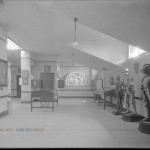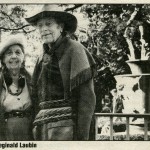For many students and surrounding community members, the University’s William R. and Clarice V. Spurlock Museum remains a hidden gem on campus. While the museum promotes learning about history and cultures all over the world, it in itself has quite a rich history at the university.
Prior to existing next to the Krannert Performing Arts Center, the museum resided on the fourth floor of Lincoln Hall from 1911 to 1998 as three separate museums; the Classical Museum, the European Cultures Museum, and the Oriental and Archaeology Museum. Over the years, the museums were merged together and renamed several times, eventually becoming one unified museum known as the World Heritage Museum in the 1970s. William and Clarice Spurlock made a generous donation in 1990 that allowed the museum to expand and relocate to a new facility. The moving process began in 1998 and the brand new World Heritage Museum opened in 2002 with a new name as well; the Spurlock Museum. [1]
With the new building and new name also came new museum philosophy changes . In a 1997 memo sent to museum staff regarding new exhibit guidelines, Sarah Wissemen said:
“The Spurlock Museum of World Cultures is a cultural-historical museum, not an art museum. Our emphasis is on the story behind the object (how it was made, how it functioned, who made it, how it reveals religious, social, or other themes) and how objects and processes change over time.” [2]
These guidelines remain true today, with artifacts on display from all over the world, each telling a story about varying spaces and time.
In 2006 Board Meeting, Professor Douglas Brewer said:
“The museum is in for bigger changes than 9 years ago when we were planning for the new building. The museum’s mission is changing: there will be more of an international flavor and the primary function is to serve students, scholarly communities, and the general public.”[3]
With such mission changes, the Museum Studies program at the University expanded with more staff as well. Students have the capability of learning more about museums through classes taught by staff members of the Spurlock Museum and even have opportunities for hands-on learning experiences. The Museum not only teaches through their galleries, but also through behind-the-scenes classes, too.
One of the most notable donors of the Spurlock Museum were Reginald and Gladys Laubin. The Wyoming couple married in 1930 and, although neither was of Native American decent, they “were adopted in 1934 by One Bull, the nephew of Sitting Bull, a Sioux chief.”[4] The Laubins were Native American experts and well-respected by both scholars and Native Americans. Over the years, they acquired many artifacts and photographs that were eventually donated to the University of Illinois. The Spurlock Museum has almost 2,000 artifacts, many of which are on display in the permanent Laubin Gallery of American Indian Cultures, in addition to over 8,000 images in the museum’s Digital Multimedia Collection. Among the many artifacts are tipis that the Laubins themselves used. The University Archives has over 50 cubic feet of the Laubin’s papers and materials, including their journals and notebooks. In a letter from Morton W. Weir, Chancellor of the university from 1987-1993, wrote to ‘Redge’ and Gladys:
“The thought of having a part of our new Spurlock Museum of World Cultures devoted to your lives and word—devoted to your search for the old ways—is truly inspiring. Students, faculty, and visitors to the campus will be educated about Native American customs, beliefs and arts in a highly personal way.”[5]
The Chancellor was very grateful for the Laubin’s work and donations to Spurlock. The new museum and accompanying artifacts instilled pride across the campus as a point of historical and cultural knowledge. Gladys Laubin herself praised the museum for its work. She said, “The Spurlock Museum offers a wonderful opportunity to display beauty, to bring us all together, just like music does.” [6]
To find out more about the Spurlock Museum, visit them Tuesday through Sunday at 600 S. Gregory St. in Urbana. For more information about the Laubins, the archive’s materials can be found here.
[1] “History of the Museum,” The William R. and Clarice V. Spurlock Museum, accessed April 1, 2015, http://www.spurlock.illinois.edu/explorations/history/history/index.html.
[2]World Heritage Museum Administrative Correspondence File, 1997-2000, Box 1, Record Series 15/34/1, University of Illinois Archives.
[3] World Heritage/Spurlock Museum Board File, 1987-2006, Box 2, Record Series 15/34/4. University of Illinois Archives.
[4] Andrea Lynn, “Wyoming Couple Give American Indian Artifacts to UI,” The Daily Illini, November 5, 1992, p. 3.
[5] Reginald and Gladys Laubin Papers, 1862-1999, Box 84, Record Series 15/34/50, University Archives.
[6] Andrea Lynn, “Wyoming Couple Give American Indian Artifacts to UI,” The Daily Illini, November 5, 1992, p. 3.



